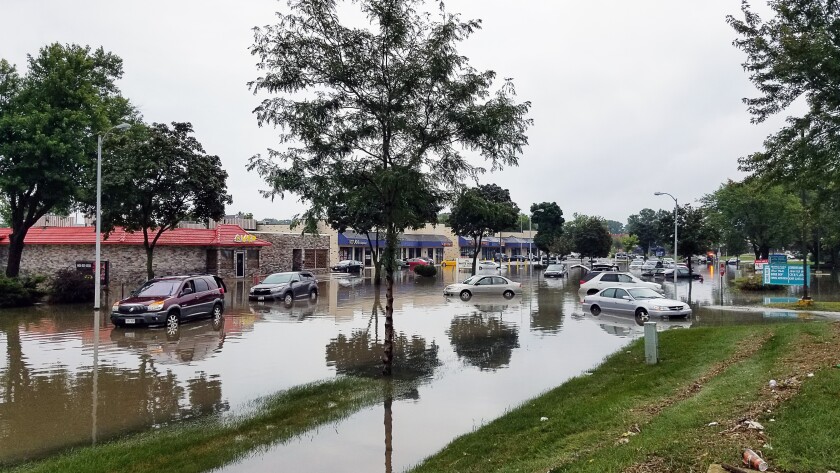Hilary made landfall in the Golden State on Sunday, as the first tropical storm to hit the state in more than 80 years.
It’s still early days but sources agree that the outcome could have been worse. The affected areas were in the west eye of the hurricane, where impacts are generally weaker, not to mention the worst rainfall had poured on low-populated mountainous areas.
“You're really looking at the Palm Springs area as the most heavily impacted [and] we're seeing some spot flooding in Arizona and Nevada,” Aon Edge CEO John Dickson said.
The main loss driver will be water, not wind, caused by inland precipitation and exacerbated by the region’s dry soil and aging drainage which was unable to absorb rainfall of such intensity.
There were nearly 50,000 power outages, and many business interruptions, with mud and debris flows resulting from the widespread floods according to Firas Saleh, Moody’s RMS director of product management.
There is no clear consensus on how the impact will be split by line of business. The more popular opinion is that it will be a larger loss event for residential than commercial, but homeowners’ insurance policies typically don’t cover flood whereas commercial property policies do.
Loss estimates from sources this week were all across the board, but those who suggested the highest numbers – up to several billions of dollars – are commercial property underwriters.
Reasons behind their concerns are two-fold: (1) most insurers never expect hurricanes in California (2) the state’s regulators are notoriously consumer-friendly.
One underwriter noted that flood ended up “being a throw-in” in policies because carriers did not anticipate the peril to be an issue in California. Restrictive measures that are common for regions along the Gulf Coast, such as deductibles for named storms, are likely absent for accounts there.
Sources are also mixed on how much of the water damage will be disputed for wind claims. There is no clear answer on this either, as carriers have different definitions and policy terms in place when it comes to flood and water damage.
For Hilary, the main issue was inland precipitation, which is relatively less likely to drive wind-related disputes compared to coastal surges. In addition, the wind speed for Hilary was mild at around 40 mph while it made its way through Palm Springs, which sources say weakens the case for wind-driven rain.
On the other hand, skeptics pointed out that disputes surrounding water damage often boil down to what the initial entry point was, which is “exceptionally hard to prove”. Some of them could end up in court, incurring expensive legal fees for both carriers and insureds.
And for insurers, California is one of the last places they would choose to go up against consumers in court.
The state has an insurance commissioner who is “exceptionally lenient towards insureds” and precedents where the insurance department declares how claims should be handled post-event.
Property sources frequently mentioned a case where commercial property carriers shared a substantial loss from the Resort Hotel Association after the 2018 mudslide in Montecito, which caused damage and guest evacuations in luxury hotels.
Mudslides were not part of their standard property coverage, but insurers ended up paying for the losses anyway as the then insurance commissioner Dave Jones claimed the 2017 wildfire was its proximate cause.
On Monday, current insurance commissioner Ricardo Lara put out a statement notifying residents that disasters like flood and mudslides, that are typically excluded by homeowners or commercial insurance policies, can be covered if they are directly or indirectly caused by a recent fire.
“I have alerted insurance companies to follow California law requiring they cover any mudslide, debris flow or other damage that is caused by our recent wildfires so that people can recover quickly,” Lara said.
Residential
Flood underwriting sources in the US say the impact will be more residential than commercial, but minimal in terms of size.
On Monday, modeling firm CoreLogic estimated that 1.55 million homes were at risk of inland flooding, including California, Nevada and Arizona.
The losses will largely be contained to domestic carriers, as London players typically provide coverage to high-net-worth (HNW) homes and areas far from the flood-affected areas.
California has one of the largest markets for HNW homeowners’ insurance. The price of an average size home in Palm Springs stood at nearly $1.3mn in July, according to a survey by Greater Palm Springs Realtors, an organization of real estate professionals in the region.
However, HNW experts told this publication that they do not anticipate a significant number of claims from Hilary, as flood is not a standard coverage provided by a homeowners’ policy, even in the HNW space.
According to Moody’s RMS, residential exposure in areas with the highest impacts from Hilary’s flooding features single-digit penetration rates for flood insurance, for both the National Flood Insurance Program and private policies.
“The insured loss versus the economic loss will probably be dramatically different as it relates to flood,” said Derek Lynch, CUO of flood MGA reThought Insurance.
Whatever the losses shake out to be, what doesn’t change is that the tropical storm has made an unusual landfall in California at a time when insurers were already tightening exposure in the state. State Farm, for example, suspended writing new policies in California for business and personal lines P&C insurance starting late May.
Kevin Daley, brokerage firm Epic’s president and leader of western region private client, noted that he feels clients in the HNW space are starting to gather awareness of the capacity crisis. An interesting point to see this year, he added, would be comparing the amount of claims filed compared to previous years.
“I don't think anyone wants to turn in anything that's not catastrophic,” he said. “So average claim value will probably be higher. And that's not because these claims are more severe – it's because we're not hearing about the small ones.”



